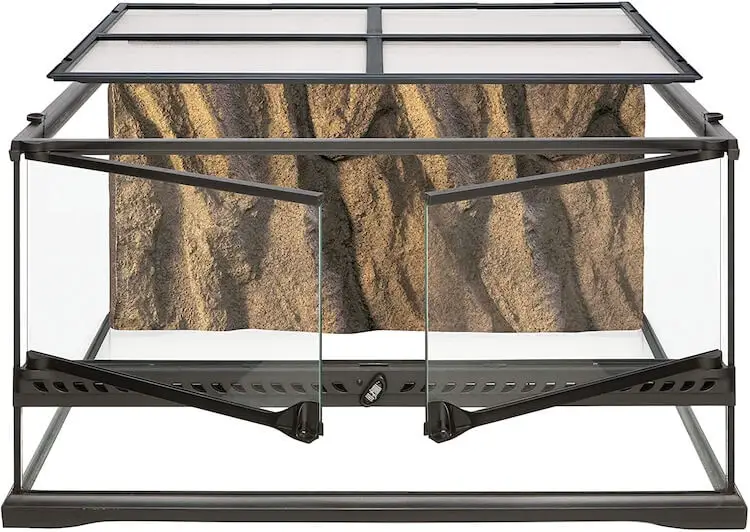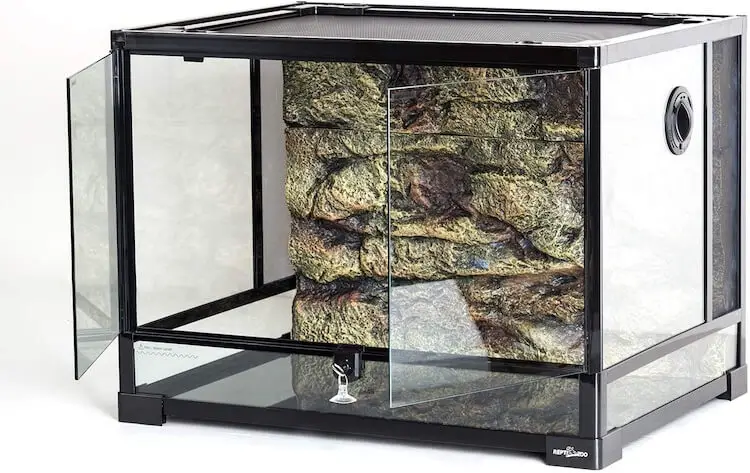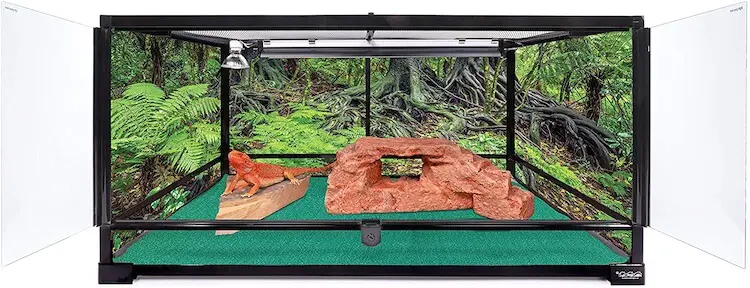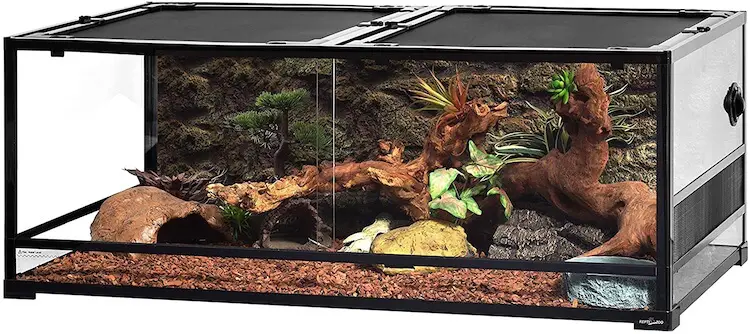Are you planning to keep a pet reptile and need to know how to set up a terrarium and what makes a good one?
The combination of tank size, substrate, door, hood, lighting and décor makes it hard to know which enclosure is best. Yet, it is possible to narrow down the best reptile terrariums.
Regardless of species, all reptile tanks must be safe, secure, enriching and big enough. Larger reptiles need more space, stronger cages, better equipment and more décor. Smaller reptiles can be housed in smaller tanks and are often more beginner friendly.
Continue reading for our complete guide on buying and setting up a reptile terrarium. We also include the best enclosure setups, necessary equipment, how to clean and décor ideas.
All About Reptile Terrariums
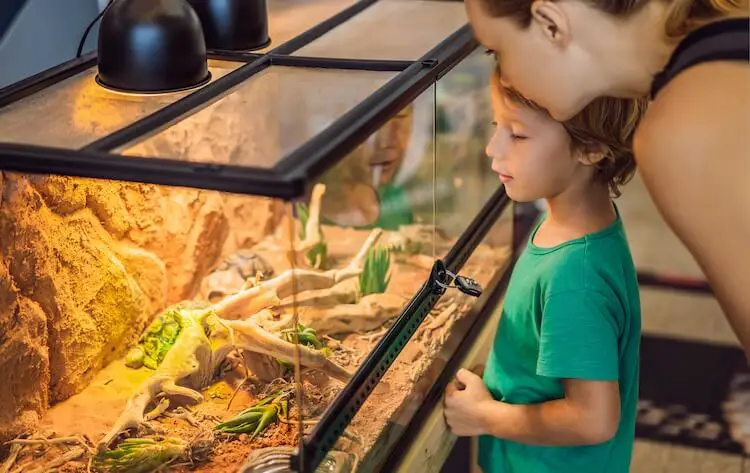
There are many design elements that the best reptile terrariums share.
Lizards and snakes are best housed in front-open enclosures. Front-opening doors let you access the terrarium without appearing threatening. A hand coming down from the top looks very similar to a predatory bird.
Turtles should have a traditional top-open tank because of their aquatic environment. But, many types of turtles are more tolerant of being picked up from the top anyway.
Many terrariums come in both “long” and “tall” variations. A 20-gallon long reptile tank is best for ground species like leopard geckos. A 20-gallon tall is better for arboreal reptiles like crested geckos.
To promote airflow and proper humidity, most reptile terrariums should have a screen mesh top. Mesh tops let light, heat, and fresh air into the tank while still being safe and secure. Some enclosures have mesh side panels to increase ventilation to make it easier to create a temperature gradient.
For most reptiles, glass is the best and most popular terrarium material.
Glass holds heat and water well, is durable and easy to see through. It also won’t be damaged by high moisture or a reptile exploring their enclosure. Glass tanks are suitable for all small-to-medium reptiles. Larger species like Burmese pythons or tegus need more space than a simple glass.
Quality also matters for a terrarium. It will save you time and money, as well as being safer for a reptile.
What Size Tank Do I Need For A Reptile?
The size of a reptile’s enclosure varies based on its age, activity, and size. Most pet lizards can live in 20-gallon tanks, but providing a larger terrarium will result in a happier and more active reptile.
Below is a table with recommended tank sizes for six popular beginner species:
| Species | Minimum Tank Size | Best Tank Size |
|---|---|---|
| Ball Python | 30 gallons | 70 gallons |
| Rat Snake | 30 gallons | 55 gallons |
| Leopard Gecko | 20 gallons | 30 gallons |
| Bearded Dragon | 70 gallons | 120 gallons |
| Yellow-Bellied Slider | 30 gallons | 55-100 gallons |
| Red-Eared Slider | 30 gallons | 55-100 gallons |
As an Amazon Associate I may earn a small commission from qualifying purchases (learn more here).
Best Reptile Terrariums
1. Exo Terra Glass 20-Gallon Reptile Terrarium
This 20-gallon reptile tank is perfect for smaller reptiles like leopard geckos, crocodile skinks, or Mediterranean house geckos. It would also be perfect for a young bearded dragon, though it’s too small to be used as an adult bearded dragon enclosure.
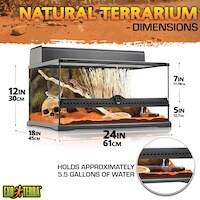
The low profile of this terrarium makes it especially suited to terrestrial, desert reptiles. Because the heaters and UVB bulbs are closer to the floor of the tank, this model would be excellent for a leopard gecko or crocodile skink.
The Exo Terra 20-gallon glass terrarium is well-built, sturdy and has great design features that make installing and using equipment easy.
We like the full mesh screen top, which is held in place by swivel locks. The mesh top can be completely lifted off the tank which makes it easier for beginners to clean their tank. The doors are front-opening too and are locked in place with a simple snap mechanism. The doors are also raised above the floor of the tank. This means you can add up to five inches of substrate for burrowing reptiles.
This model also comes with a realistic foam backdrop. The backdrop has built-in grooves to hide wires and cables, but it also takes up some of the limited floor space. It also makes it harder to install a substrate like stone tiles or slate.
Pros:
- Sturdy build and thick glass sides.
- Full screen top for ventilation.
- Great starter size for many juvenile species.
Cons:
- Foam background takes up limited space.
- Substrate can be tricky to install and remove.
- Too small for some larger reptiles.
2. REPTI ZOO Glass 35-Gallon Reptile Tank
This 35-gallon enclosure is a great choice for many species including: corn snakes, Kenyan sand boas, fat-tailed geckos or long-tailed lizards. The tank design is configured for reptiles who like to both climb and burrow.
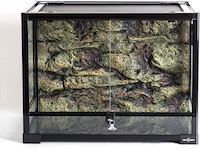
REPTI ZOO’s large terrarium has several unique design elements that put it above and beyond other tanks in its category. Extra mesh ventilation panels also make this tank ideal for arid reptiles that need low humidity.
We like this enclosure’s large, hinged doors that have a lock-and-key mechanism for security. The doors and sides are also built from thick glass with low reflectivity. Low reflectivity glass makes it perfect for viewing your reptile without them becoming stressed.
The left side of this reptile terrarium has an adjustable cable port for temperature probes, lights, or aerators. The top is a single piece of wide-woven mesh that snaps in place. This increases airflow and filters out less UVB than tighter mesh, a feature we love. The single mesh panel makes it easy to install strip lights without having a crossbar in the way.
The bottom of the tank features a deep, water-tight area for layering substrate or installing a water feature. This is especially great for reptiles that like to soak and may spill water from their bowls. The base is also raised at the corners to facilitate an under-tank heater.
Pros:
- Superior ventilation thanks to screen top and side panels.
- Single-piece mesh top for strip lights and heaters.
- Deep base for substrate and high corners for a heater.
- Adjustable cable port for wires and probes.
Cons:
- Extra mesh panel on side panels causes humidity loss. For this reason, we think this particular terrarium is better suited for keeping temperate and arid reptiles instead of tropical ones.
3. Carolina Custom Cages 50-Gallon Terrarium
This 50-gallon enclosure is great for reptiles that need a bit more room like many species of gecko and some snakes. This terrarium is very sturdy, and is great for tropical to arid reptiles. A tank of this size would be wonderful for a chameleon or armadillo lizard.

We love the easy setup and fantastic design of this tank. Its functional features like raised corners, wide screen and clear glass make it a very high-quality terrarium. It is a great choice for most reptiles.
This Carolina Custom terrarium is one of the best enclosures in terms of construction, safety and functionality.
It features hinged doors that lock securely with a key and won’t be pushed open by an exploring reptile. The glass is thick, clear, and is unobstructed by support bars.
This tank’s screen top is securely snapped down and has wide mesh holes. These holes allow higher levels of UVB light, but they also make it difficult to maintain high humidity levels. Despite this flaw, it is one of the best reptile tanks on the market. It is a great enclosure for both new and experienced keepers who are looking to invest in a larger setup for their reptile.
Pros:
- Clear and sturdy glass sides for an unobstructed view.
- Wide mesh top for extra UVB penetration.
- Great starter size for many juvenile species.
4. REPTI ZOO Glass 85-Gallon Reptile Enclosure
This roomy tank is our top choice for 85-gallon terrariums. It has a sturdy construction and would be an excellent pick for many popular pets like bearded dragons, ball pythons, rat snakes, and king snakes.
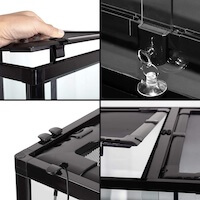
This fantastic terrarium is an ideal size and gives plenty of room for your reptile to explore, climb, bask and dig. It not only has a wide floor area but also a lot of headroom. This allows you to place décor in all directions.
We love this tank’ solid design and large size! Despite its large size, it has an easy assembly process and feels very secure once put together.
It features a double sliding front door with a key lock for extra security. The sliding doors can be opened slightly, or the full length of the enclosure. This makes it easy to clean the interior, handle your reptile, or simply mist the tank.
This model comes with an extra feature we love, a two-part mesh top.
REPTI ZOO’s terrarium has a mesh top that can be removed in two separate parts. This makes cleaning the tank or adding décor very easy. The top edge of the tank also has closable gaps for running temperature probes or extra cables into the interior.
This large terrarium is very high quality and thoughtfully designed. We highly recommend it for beginners who are looking for a larger enclosure.
Pros:
- Excellent quality and easy assembly.
- Added mesh panel for best ventilation.
- Plenty of room for your reptile to explore, climb, bask and dig.
Cons:
- Cable port on the left side blocks the view into the tank.
Equipment
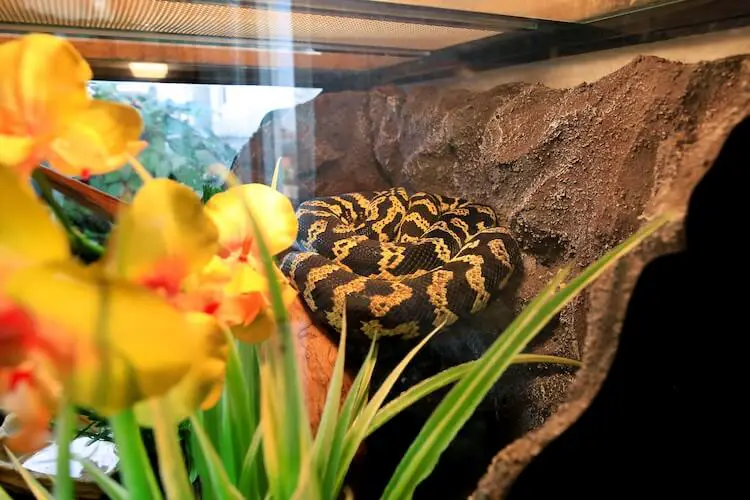
Keeping reptiles requires more than just a terrarium. Extra equipment for heating, lighting, and monitoring the environment in the enclosure is required too.
The specific setup and equipment will vary based on your species, but the basic needs of temperature gradients and humidity control are the same. It is important to buy this equipment and have it setup prior to bringing home your reptile.
Light and Fixtures
Daytime lighting helps reptiles regulate their circadian rhythm and synthesize vitamin D. Reptiles who have a suitable UVB light in their terrarium have higher levels of vitamin D in their blood. This reduces the risk of metabolic bone disease. This is true for nocturnal and crepuscular reptiles too, a good example is the leopard gecko.
The best daytime lighting is a UVB bulb.
Tank size and species will determine the style and strength of the light fixture. Long terrariums are usually fitted for strip lights and tall terrarium for dome lamps, with bulbs of varying strengths made for each one.
To maintain a proper day/night cycle, use a timer to automatically turn the UVB bulb on and off. Most reptiles are happy with an 8:00am to 10:00pm cycle in the summer and 9:00am to 9:00pm in the winter.
Heater
Just like reptiles need light, they also need heat. Reptiles are cold-blooded animals, so they need external heat sources to digest food and gain energy. Their metabolism is determined by the temperature around them. Warmer reptiles have faster metabolisms and are more active and alert.
There are three different types of heaters:
- Ceramic bulbs.
- Basking bulbs.
- Under-tank heaters.
Ceramic bulbs and under-tank heaters do emit any light. They always need to be used with a separate light fixture.
Basking bulbs emit heat and light, but they need to be turned off at night. If you use a basking bulb, a different heat source for night is needed. Many people use a UVB basking bulb with a ceramic bulb.
The heater should always be placed on one side of the tank. This will help to create a temperature gradient. Temperature gradients let your reptile choose its own basking temperature and mimics their natural environment.
Thermometer, Thermostat and Hygrometer
There are also some less obvious pieces of equipment that are just as important for reptile terrariums.
Firstly, you will need two thermometers.
One thermometer should be used for measuring surface temperature; this is normally an infrared thermometer and should have two probes. Place one probe on the warmest side of the tank and one on the coolest side. If you only have one thermometer probe, it should be placed in the hottest part of a terrarium, close to the basking spot.
The other thermometer is used for measuring air temperature. Measuring surface and surface air temperatures will make sure both the air and the substrate are correct.
You will also need to use a thermostat to regulate the output of your heaters. A thermostat will automatically turn off your heater if it gets too hot.
A hygrometer measures humidity levels in the air. Low humidity can be dangerous for tropical or exotic pets, while high humidity is bad for desert reptiles.
Décor
Every terrarium should cover your reptile’s basic needs.
This normally includes a water bowl (or pool for aquatic species), multiple enclosed hides, branches (or other climbable décor), plants and a suitable substrate.
Your reptile’s water bowl is best placed on the cool side of the terrarium. This will slow down evaporation and keep the water at a comfortable temperature for drinking.
The amount of substrate to add depends on how much your reptile likes to burrow. Species like bearded dragons like several inches of substrate for digging. Chameleons or tree boas are fine with a thin layer as they do not dig.
Before adding décor you should make sure it is thoroughly cleaned and dried.
If using branches, leaf litter, or rocks from outside, sterilize them too. Leaves and branches can be baked at 250 to 300 degrees Fahrenheit for 60 minutes to kill any pathogens. Rocks should be soaked in a 10% bleach solution for 30 minutes and then rinsed completely.
How To Set Up A Reptile Enclosure
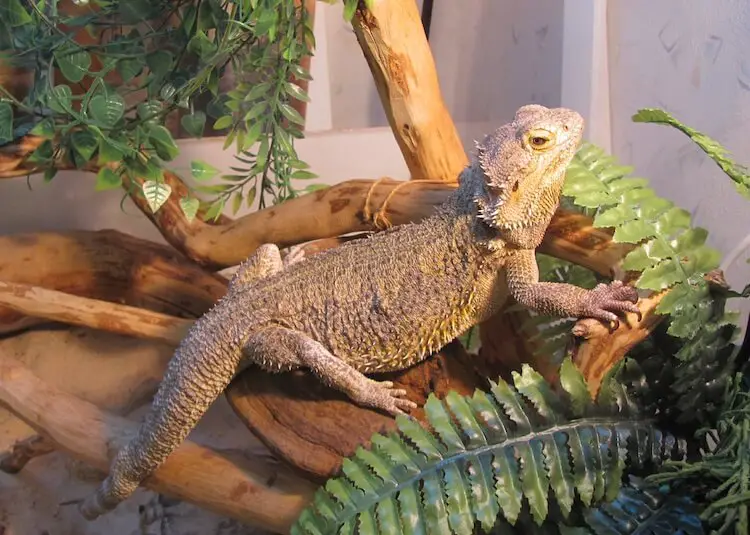
Step 1. Assemble The Terrarium
Most reptile tanks 40-gallons and smaller can be found at a pet store and can be purchased assembled. Larger tanks will need to be ordered online and usually arrive disassembled.
Glass terrariums are heavy, so assembly will require two people.
It is a good idea to decide where you are going to put your terrarium before buying one.
This will help to minimize handling and make sure you avoid common mistakes like putting a tank in front of a window.
A terrarium should be out of direct sunlight, away from air vents or open windows, and out of the reach of young children.
Reptile tanks should be on some type of stand. This can be a custom-built stand or a cabinet. A stand allows for air to flow underneath the tank, this is especially important for an under-tank heater.
Step 2. Install Lights and Heaters
After you have assembled and positioned your terrarium, the next step is to add the lights and heating elements.
Most light fixtures (excluding basking bulbs) can be placed directly on the screen top. However, we would recommend that you always use a separate stand.
Ceramic heaters and basking bulbs should always be used with an adjustable stand. These stands have an adhesive panel that sticks to the side or back of the tank, and an adjustable overhanging section to hang the light fixture from.
Under-tank heaters adhere to the outside bottom or side of the enclosure. They cannot be removed once placed.
At this point, you will also want to add the thermometers and hygrometer to the enclosure. You should also configure the thermostat and light timers.
Step 3. Add Substrate and Décor
This step is by far the most exciting and lets you create an enriching enclosure for your reptile.
Get creative with your décor, so long as it is nontoxic and safe for reptiles.
If you decide to use live plants, or a water feature, install them at this point as well.
Step 4. Wait Three Days
You may be tempted to use your enclosure as soon as it is ready. But, you should wait two or three days before introducing your reptile. Just run the lights and heaters as normal.
It is important to let the environment in the enclosure stabilize. It also gives you time to make any adjustments to the light cycle, temperature gradient or heater’s position.
Check the tank temperature and humidity every four hours to make sure they are within the day and night ranges.
Once you can control the temperatures and humidity properly, your terrarium is ready!
Tank Setup Ideas
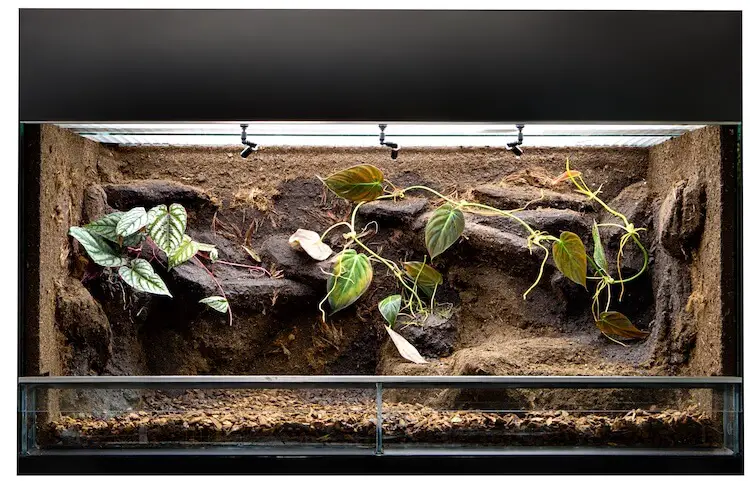
There are many different ways to set up a reptile terrarium. Setups range from practical and low maintenance to intricate and extremely natural.
First-time keepers usually want décor that is simple, easy to clean, and attractive. For tanks smaller than 20-Gallons, the setup below works very well:
- Fake plants or a shredded t-shirt “hanging plant”.
- Foam background or black construction paper background.
- Large piece of driftwood.
- Reptile hammocks.
- Connected paper towel tubes for tunnels.
- Reptile carpet.
- Upside down plastic containers or cardboard shoeboxes for hides.
- Ceramic or stone water bowl.
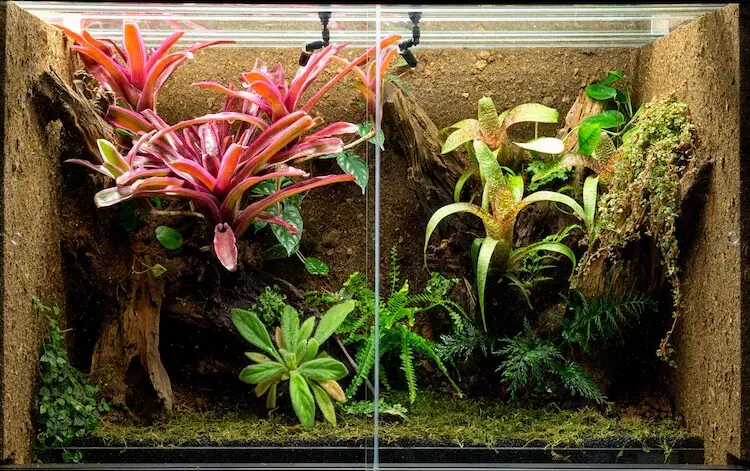
For experienced owners, setups can become more intricate. Many keepers like a natural enclosure that closely mimics a real environment. This type of terrarium setup requires more upkeep than plastic décor:
- Real species-appropriate plants (e.g. succulents for arid reptiles).
- Cork or bark background
- Stones and logs
- Leaf litter, moss, and organic soil.
- Wooden branches and hides.
- A water feature or waterfall (for tropical species)
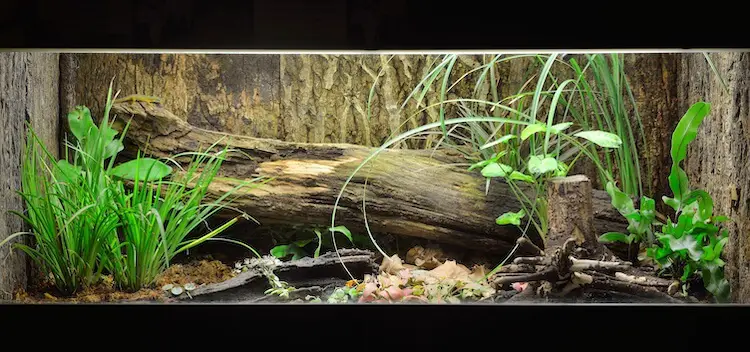
Cleaning a Terrarium
Keeping a reptile enclosure clean is a very important part of husbandry. Too much waste in your reptile’s enclosure can cause parasites, bacterial infections and stress. This is especially true for aquatic turtles, who need their swimming water cleaned with an aquarium filter.
There are two types of cleaning, spot cleaning and deep cleaning.
Spot cleaning is a daily task that involves removing any visible waste and uneaten food from your reptile’s tank. Keeping up with spot cleaning means you will have to deep clean less often.
Deep cleaning is a more involved cleaning process. But, it only needs to be done twice a month.
| Week | Cleaning Schedule |
|---|---|
| 1 | Spot clean – 6 days Deep clean – 1 day |
| 2 | Spot clean – 7 days |
| 3 | Spot clean – 6 days Deep clean – 1 day |
| 4 | Spot clean – 7 days |
Deep Cleaning a Reptile Tank
- Move your reptile to a temporary container.
- Take out all décor and substrate.
- Wash the tank and décor using a sponge with hot water and a nontoxic soap (e.g. Dawn detergent). Fully clean the floor and sides.
- Once washed, rinse thoroughly with warm water.
- Dilute a mixture of bleach and water (1/2 cup bleach to 1 gallon water).
- Disinfect the tank and décor.
- Let the tank sit for at least 10 minutes.
- Rinse everything with hot water to remove all soap and bleach residues.
- Let the tank and décor dry completely.
- Reassembling the tank, add fresh substrate and reintroduce your reptile.
How To Clean A Reptile Tank With Vinegar
Terrariums can also be cleaned with white vinegar. White vinegar is not as powerful as bleach, but it still works well. Follow the same ten steps above, but instead use a 50:50 mixture of water and vinegar. It is still just as important to rinse the tank after cleaning so no vinegar remains in the enclosure.
Most Common Tank Setup Questions
Can I Put Sand In A Reptile Terrarium?
This depends on the reptile, but the answer is almost always no. Most popular pet reptiles are not well suited for sand and it can cause health problems such as impaction. A few species, such as the Kenyan Sand Boa, live on sand and can have sand in their tanks.
How Can I Keep Humidity High In A Reptile Terrarium?
For most reptiles it is as simple as keeping a water dish in the tank. This will keep humidity at 30 to 50%. More tropical species need higher humidity, so a fine mister or a spray bottle should be used. Liberally misting the inside of the tank each day will keep humidity at 70 to 80%, perfect for chameleons! Tank design is an important aspect of humidity too. Glass terrariums are the best at maintaining heat and humidity.
Reptile Tank vs. Fish Tank: What’s The Difference?
Fish tanks and reptile tanks look very similar but have some differences in their design. Fish tanks are tightly sealed with caulk to make them watertight. They are always top-open too. Reptile tanks are normally front-open and come with mesh screen tops.
Summary
Choosing the best reptile terrarium is the first step to giving your pet a long, happy life. Along with tank choice, keeping it clean and using the right equipment is also important to maintaining the health of your reptile.
Most tanks for reptiles are made of glass and come with metal mesh screen tops. These mesh tops allow light and heat penetration along with airflow and humidity control.
Bad reptile terrariums are plastic bins, or opaque containers, with tightly sealed tops and no ventilation holes. Plastic enclosures should only be used for transporting or temporarily housing a reptile during a clean.
Reptile tanks usually come in “long” and “tall” variations. Leopard geckos, uromastyx, and box turtles, need tanks that are longer than they are tall. The opposite is true for arboreal species like day geckos, rat snakes, and chameleons.
Have any questions about choosing the best terrarium for your reptile? Let us know in the comments.

